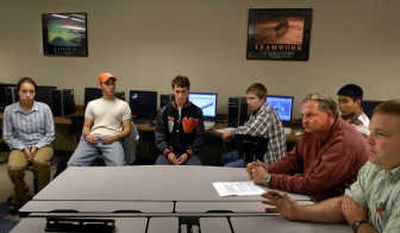Whale of an invention

A dream to create a more efficient way to transport fish over dams has fueled innovative plans by a team of West Valley High School students.
Their idea for designing a tubular device or “escalator” to draw fish up has caught the attention of key players with the Lemelson Foundation and the Massachusetts Institute of Technology, to the tune of winning a grant worth up to $10,000 to develop a prototype.
The seven students working with WVHS engineering/physics teachers Eric Groshoff and Brad Liberg recently won the grant through a program called InvenTeams, promoting imaginative invention ideas. The West Valley group was one of 16 high school teams chosen nationally from more than 60 original applicants.
“The idea we’re developing is a fish auger that draws the fish up,” said WVHS senior Alex Hanson. “The idea is as the auger rotates, and as water currents flow through it, it would bring fish up with the water.”
“The fish would be drawn up, rather than using a ladder.”
The students had originally hoped to find solutions for Grand Coulee Dam but learned that there are no potential upstream spawning grounds, so they switched to studying designs for ferrying fish – especially salmon – over Snake River dams that are now impassable.
“Hells Canyon Dam would be perfect because of the potential for spawning grounds,” Hanson added.
Hanson is working with students Gavin Mitchell, Senaida Monroy, Anh Phan, Matt Tremblay, Keith Woehrlin and Henrique Dantas. Team members worked this past summer and now meet before and after school and during some free class time.
“They have worked fairly independently,” said Groshoff, who with Liberg attended a national robotics competition last year with students where they learned about the grant competition. “We’re at the point now that they’ve researched it, and we can actually come up with a prototype.”
“They’ll have to go out to solicit some community support to help build this, such as for manufacturing, and getting more information from Fish and Wildlife.”
MIT officials are expected to visit the school a couple of times this school year and by June 2008, the students will travel to MIT to present their work. The student team also will make trips to area dams, Groshoff said, and they have the potential to continue the work into a second year or as part their college experience.
The process has required the students to make budget decisions on how to apply the grant toward such items as sheet metal, electrical supplies, acrylic and sprockets, among other materials for small-scale models they can test with fish.
“The plan is to get some type of large fish tank and type of fish we can use to test the prototype,” said Woehrlin.
According to Liberg, another goal is to prove their research-based ideas. “The goal is to get a good start. They will start with something small and find any failures.”
“The ultimate goal is to patent it with MIT’s guidance,” added Tremblay. “The other reason for this invention is that fish ladders today have some flaws. This (new) device would definitely lessen the amount of fish that die.”
The students explained that some fish die going through traditional systems because oxygen and nitrogen levels can get too dense and temporarily stun the fish, which leaves them vulnerable to predators.
Hanson added that the group is thinking long-term. “Hopefully 10 years from now we’ll have a fish ladder like this at Hells Canyon Dam,” or at other dams, he said.
The Lemelson-MIT Program encourages students to identify real-world problems and invent practical solutions using math, science and engineering. Out of some 60 applicants this year, the winners were narrowed down to teams whose ideas had real potential.
Jerome H. Lemelson, one of the world’s most prolific inventors, and his wife Dorothy founded the Lemelson-MIT Program in 1994. It is funded by the Lemelson Foundation. Other student-led ideas this year include: a human-powered irrigation pump, robotic coconut tree-climbing device and a weight-stabilizing compact stretcher.